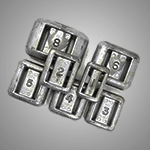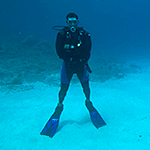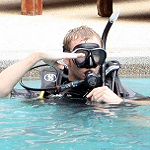Why “the least weight possible?”
 Always wear the least weight possible. You hear this consistently from experienced dive professionals. What you may not understand is why.
Always wear the least weight possible. You hear this consistently from experienced dive professionals. What you may not understand is why.
(more…)
 Always wear the least weight possible. You hear this consistently from experienced dive professionals. What you may not understand is why.
Always wear the least weight possible. You hear this consistently from experienced dive professionals. What you may not understand is why.
(more…)
 The other day, I got an interesting comment on a photo I posted way back in December. The photo (shown below) is a still-frame capture from a You Tube video. The video was actually pretty good, showing both diving and a specific destination in a positive light. Unfortunately, that’s not what many viewers are going to remember.
The other day, I got an interesting comment on a photo I posted way back in December. The photo (shown below) is a still-frame capture from a You Tube video. The video was actually pretty good, showing both diving and a specific destination in a positive light. Unfortunately, that’s not what many viewers are going to remember.
 Most dive instructors would agree that it is far harder to break bad habits than it is to never allow those habits to form in the first place. It’s why we are so adamant about students not putting masks on foreheads or leaving tanks standing upright unattended. Yet, despite this, most instructors allow students to form four of the worst possible habits just by continuing to teach “the way we’ve always done it.” Some divers manage to break these habits with time; many never do.
Most dive instructors would agree that it is far harder to break bad habits than it is to never allow those habits to form in the first place. It’s why we are so adamant about students not putting masks on foreheads or leaving tanks standing upright unattended. Yet, despite this, most instructors allow students to form four of the worst possible habits just by continuing to teach “the way we’ve always done it.” Some divers manage to break these habits with time; many never do.
 At the surface, a properly weighted diver will float at eye level. This statement, or one like it, appears in virtually every diver training organization’s materials. What you won’t find agreement on is whether this is with a full lung of air or half a lung of air. It may also be unclear is whether this is done which a full tank or one that is closer to empty. It doesn’t matter. No matter what your Open Water Diver manual says, it’s probably wrong. At least much of the time. Why is that?
At the surface, a properly weighted diver will float at eye level. This statement, or one like it, appears in virtually every diver training organization’s materials. What you won’t find agreement on is whether this is with a full lung of air or half a lung of air. It may also be unclear is whether this is done which a full tank or one that is closer to empty. It doesn’t matter. No matter what your Open Water Diver manual says, it’s probably wrong. At least much of the time. Why is that?
(more…)
 Go to Google Images. Search for Neutral Buoyancy. Along with images of the NASA Neutral Buoyancy facility and Neutral Buoyancy Turtle, you’ll see a lot of photos like the one on the right. To most divers — and, sadly, most instructors — the so-called Buddha Hover is synonymous with buoyancy control. Unfortunately, as Penn and Teller would say, it’s total bullshit. And here are seven reasons why.
Go to Google Images. Search for Neutral Buoyancy. Along with images of the NASA Neutral Buoyancy facility and Neutral Buoyancy Turtle, you’ll see a lot of photos like the one on the right. To most divers — and, sadly, most instructors — the so-called Buddha Hover is synonymous with buoyancy control. Unfortunately, as Penn and Teller would say, it’s total bullshit. And here are seven reasons why.
(more…)
![]() There is an instructor practice that we’ve all seen but I don’t think any of us has actually commented on it. The practice is using the bottom (pool, sea, training platform in quarry or lake) as a training assistant. This is actually the basis for exercises such as fin pivots and other exercises that do not teach proper buoyancy control. This practice is widespread and entrenched in teaching exercises starting at Introduction to Scuba on up.
There is an instructor practice that we’ve all seen but I don’t think any of us has actually commented on it. The practice is using the bottom (pool, sea, training platform in quarry or lake) as a training assistant. This is actually the basis for exercises such as fin pivots and other exercises that do not teach proper buoyancy control. This practice is widespread and entrenched in teaching exercises starting at Introduction to Scuba on up.
(more…)
![]() Most dive instructors (and their training agencies) will tell you it’s unrealistic to expect beginning divers to master much in the way of buoyancy control. That, in order to achieve even a modest degree of control over buoyancy, students really need to enroll in a Buoyancy Control Specialty Diver course immediately upon certification. We’re here to tell you that’s bullshit.
Most dive instructors (and their training agencies) will tell you it’s unrealistic to expect beginning divers to master much in the way of buoyancy control. That, in order to achieve even a modest degree of control over buoyancy, students really need to enroll in a Buoyancy Control Specialty Diver course immediately upon certification. We’re here to tell you that’s bullshit.
![]() Odds are, you learned that the object in the accompanying picture is called a Buoyancy Control Device or BCD. The funny thing is, most of the companies that make this equipment — not to mention the majority of dive magazines and training agencies — don’t call it that.
Odds are, you learned that the object in the accompanying picture is called a Buoyancy Control Device or BCD. The funny thing is, most of the companies that make this equipment — not to mention the majority of dive magazines and training agencies — don’t call it that.